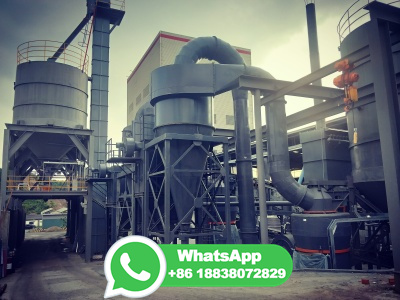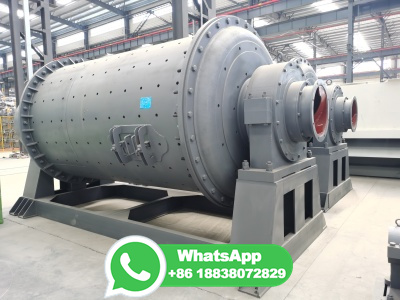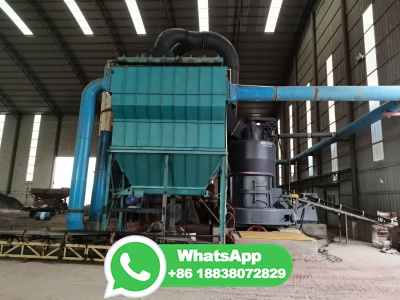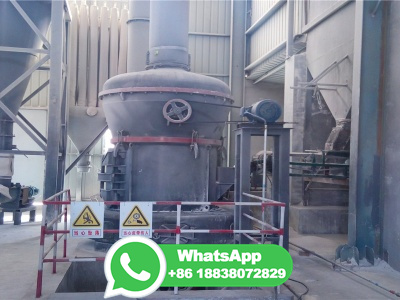
WEBApr 12, 2015 · Carboxylmethyl cellulose (CMC) has become a commercial organic binder in agglomeration of iron ore concentrates. The relative molecular mass and degree of substitution (DS) of CMC have a large impact on its binding performance. The interaction mechanism between CMC and iron ore particles was analyzed through Zeta potential .
WhatsApp: +86 18203695377
WEBJul 5, 2021 · Pelletizing is one of the agglomeration methods for iron ore concentrate. The iron ore pellets have a high compression strength, high reducibility and superior softeningmelting properties [1][2 ...
WhatsApp: +86 18203695377
WEBMay 11, 2024 · The thermal efficiency for the pelletizing process is intrinsically linked to the diameter and humidity of the iron ore pellets, so that the sensing of the granulometric range in the formation of the pellets becomes essential to the flow of the pelletizing process in the steel industry; this paper presents the assembly of a computer vision system for the .
WhatsApp: +86 18203695377
WEBFeb 25, 2018 · The iron ore sintering process was simulated and computational domain was the same as the configuration of a sinter pot as shown in Fig. 1. Entrance of the sinter pot was defined as a velocity inlet. The magnitude of velocity was obtained from the experimental gasflow rate [7]. The bottom of the sinter pot was set to be pressure outlet .
WhatsApp: +86 18203695377
WEBDec 1, 2023 · The work proposes a perspective on the direct reduction of iron (DRI) using hydrogen. Typically, iron is produced in blast furnaces (BFI) by the reduction of iron ore with carbonrich materials such as coal or coke. Greenhouse emissions may be drastically reduced by introducing DRI coal/oilbased, and further reduced by using methanebased .
WhatsApp: +86 18203695377
WEBMar 18, 2020 · According to the National Bureau of Statistics of China, the output of pig iron of China exceeds billion tons in 2018 [], and the sintering agglomeration products were the major raw materials for the iron smelting the rapid development of iron and steel industry during the past 10 years, highquality iron ore resources are .
WhatsApp: +86 18203695377
WEBEditorial Reviews. Agglomeration of Iron Ores covers in considerable detail both the sintering and pelletising of iron ore fines and concentrates that are generated along with lump ore in iron ore mines around the world, either naturally or after upgrading in a beneficiation process. The book is devoted to a detailed treatise of the sintering and .
WhatsApp: +86 18203695377
WEBJul 28, 2023 · The obtained structural change of the sintering bed show that the proposed model is a potential tool to analyse the agglomeration phenomena occurring in the iron ore sintering process under ...
WhatsApp: +86 18203695377
WEBA study was carried out to compare the environmental impacts of the two major iron ore agglomeration processes, sintering and pelletising, using life cycle assessment (LCA) methodology._x000D_ The following agglomeration processing routes, with the fuel options shown, were investigated: sintering with combined natural gas/coke breeze or .
WhatsApp: +86 18203695377
WEBMay 7, 2023 · Composition: Iron ore is primarily composed of iron, usually in the form of iron oxides such as hematite (Fe2O3), magnetite (Fe3O4), or goethite (FeO (OH)). It may also contain other elements or minerals as impurities, such as silica, alumina, phosphorus, sulfur, and trace elements. Physical properties: Iron ore is usually hard, dense, and heavy.
WhatsApp: +86 18203695377
WEBJan 1, 2015 · Sintering is the most economic and widely used agglomeration process to prepare iron ore fines for blast furnace use. In this chapter, the sintering process is first described and the key steps of the sintering process, namely, granulation and thermal densifiion, are is then focused on the effect of the chemical, .
WhatsApp: +86 18203695377
WEBJul 16, 2016 · One binder that is widely used in the production of ironore pellets is bentonite. The main mineral in bentonite – montmorillonite – has a unique ability to absorb water and undergoes a significant increase in volume. This phenomenon is called swelling . Study of the kinetics of swelling shows that this process is near completion after 24 h.
WhatsApp: +86 18203695377
WEBFeb 1, 2023 · The agglomeration behavior of particles significantly impacts on the defluidization occurring in a fluidized bed during the direct reduction process. The influence of CO/H2 ratio on surface diffusion of iron atoms was proposed, and the solid bridge force between iron oxide particles was quantifiionally analyzed. Moreover, the solid bridge .
WhatsApp: +86 18203695377
WEBVanadium titanomagnetite is a kind of multisymbiotic iron ore mainly composed of iron, accompanied by vanadiatitania and various valuable elements (such as chromium, cobalt, nickel, and scandium ...
WhatsApp: +86 18203695377
WEBJul 20, 2020 · Surface morphology evolution in the reduction of fine iron ore in a conical fluidized bed reactor under various conditions was investigated. Regime diagrams of morphology on iron ore reduction with H 2 were obtained for choosing appropriate operating condition. The result indies that it is beneficial to inhibit the formation of .
WhatsApp: +86 18203695377
WEBSep 14, 2017 · Here the study focuses on the appliion of selective flocculation process for beneficiation of synthetic mixtures of iron ore and kaolinite as well as iron ore tailings. Results show that it is ...
WhatsApp: +86 18203695377
WEBAs the world leader in tumble growth agglomeration, FEECO provides a variety of services and equipment for iron ore pelletizer plants. As the needs of the steel industry change, one production component looks to be increasingly important in meeting the needs of the modern steel industry: iron ore pelletizing. Iron ore pelletizing, or balling, is the .
WhatsApp: +86 18203695377
WEBJan 1, 2013 · Indian iron ore deposits are also soft and friable in nature, hence large amount of fines are generated. Solid wastes of steel plants are produced from process units and pollution control equipments.
WhatsApp: +86 18203695377
WEBOct 26, 2010 · The most common agglomeration technique is pelletization, which requires the use of binders to hold the iron oxide grains together so that the agglomerates can be sintered into highstrength pellets. Although bentonite clay is the most commonly used binder, there are many other possibilities that could be competitive in a number of .
WhatsApp: +86 18203695377
WEBJul 23, 2021 · For efficient operation of a blast furnace, a completely fluxed (CaO/SiO 2 = – for different melting conditions) agglomerated (10–60 mm) iron ore material with the highest economically feasible iron content is required, uniform in chemical composition and size, preferably with the maximum permissible residual carbon content for the .
WhatsApp: +86 18203695377
WEBJun 8, 2023 · Iron ore sintering is the iron ore powder agglomeration process that changes fine iron ore powder into the lumpy ironbearing raw material used for blast furnace ironmaking. Hightemperature process and addition of alkaline flux will improve metallurgical performance of ironbearing raw material. Besides, the sintering process .
WhatsApp: +86 18203695377
WEBFeb 9, 2017 · Mineralization testing process included ore matching, agglomeration, roasting and mineralogical analysis. Iron ores and fluxes (dolomite, limestone, and quicklime) were mixed to a feed, which then was used to produce sinter with SiO 2 %, basicity (CaO/SiO 2 ) and MgO %, the proportions of each material were shown .
WhatsApp: +86 18203695377
WEBNov 26, 2020 · A program of this nature was used for investigating the agglomeration characteristics of various iron ore concentrates. The factors which control the process were studied and subsequently controlled for these investigations. ... The laboratory tests were carried out on five different iron ore concentrates, designated as M1, M2, M3, .
WhatsApp: +86 18203695377
WEBSep 4, 2019 · emissions of NO x from the combustion process in heated sections of an induration machine hearth; emissions of SO 2, determined by the sulfur content in iron ore material (concentrate); dust emissions due to mechanical removal of dispersed particles of raw pellets, indurated pellets during unloading from the induration machine, their sieving ...
WhatsApp: +86 18203695377
WEBMay 8, 2011 · In a reduction roasting process the nonmagnetic iron is converted into magnetite (Fe 3 O 4), or maghemite (γFe 2 O 3). Ore fines of 0–3 mm were treated with coal (10, 15, and 20%) at different temperature (500–750 °C) and passed through the low intensity magnetic separator (– Tesla). The iron present in the form of hematite ...
WhatsApp: +86 18203695377
WEBOct 20, 2022 · Iron ore handling, which may account for 20–50% of the total delivered cost of raw materials, covers the processes of transportation, storage, feeding, and washing of the ore en route to or during its various stages of treatment in the mill.. Since the physical state of iron ores in situ may range from friable, or even sandy materials, to monolithic .
WhatsApp: +86 18203695377
WEBFeb 15, 2024 · In the actual reduction process, the temperature distribution within the reactor is not uniform, and the reduction of iron ore is controlled by different kinetic processes (Huang et al., 2012). Hammam et al. (2021) compared the reduction pathways of iron ore using coal and wood charcoal as reducing agents. The results indied that .
WhatsApp: +86 18203695377
WEBSep 1, 1974 · The pulp density is also important. Recovery of iron units was of the order of 85 for the beneficiation of the crude ore, this is much higher than yields obtained by other methods. The feed material, grading % iron and % phosphorus was concentrated to % iron containing ~% phosphorus and % silica.
WhatsApp: +86 18203695377
WEBTherefore, various agglomeration processes are used to deliver such finer raw materials to the blast furnace. Küttner is involved in these processes at various points. Sintering The most common agglomeration process is the sintering of fine ore. As a rule, larger amounts of circulation material are used in the sintering plant.
WhatsApp: +86 18203695377
Agglomeration of Iron Ore. The three major forms of iron used in ironmaking are pellets, lump, and sinter. ... In recent years, sinter feed has proven to be a good place to blend in various process dusts and sludges that contain iron values, but cannot be directly fed into the furnace. In addition, fluxes that might otherwise be added ...
WhatsApp: +86 18203695377
WEBThe typical properties of the iron ore pellets are given in Tab 1. Process technology. There are four stages involved in the production of iron ore pellets. These stages consist of (i) raw material preparation, (ii) formation of green balls or pellets, (iii) induration of the pellets, and (iv) cooling, storage and transport of pellets.
WhatsApp: +86 18203695377
WEBMay 30, 2021 · Iron Ore Raw Material . Two types of iron bearing materials in this work came from Gansu Province, China, and they were labelled as samples A and B. Sample A is return fines of sinter generated in the sintering process; sample B is iron ore fines containing titanium, which could decrease the cost of protecting blast furnace lining.
WhatsApp: +86 18203695377
WEBJan 1, 2015 · Composite agglomeration process (CAP) of iron ore fines has been proved an effective route for ironmaking burden production, and is characterized by low the fuel consumption and high the ...
WhatsApp: +86 18203695377